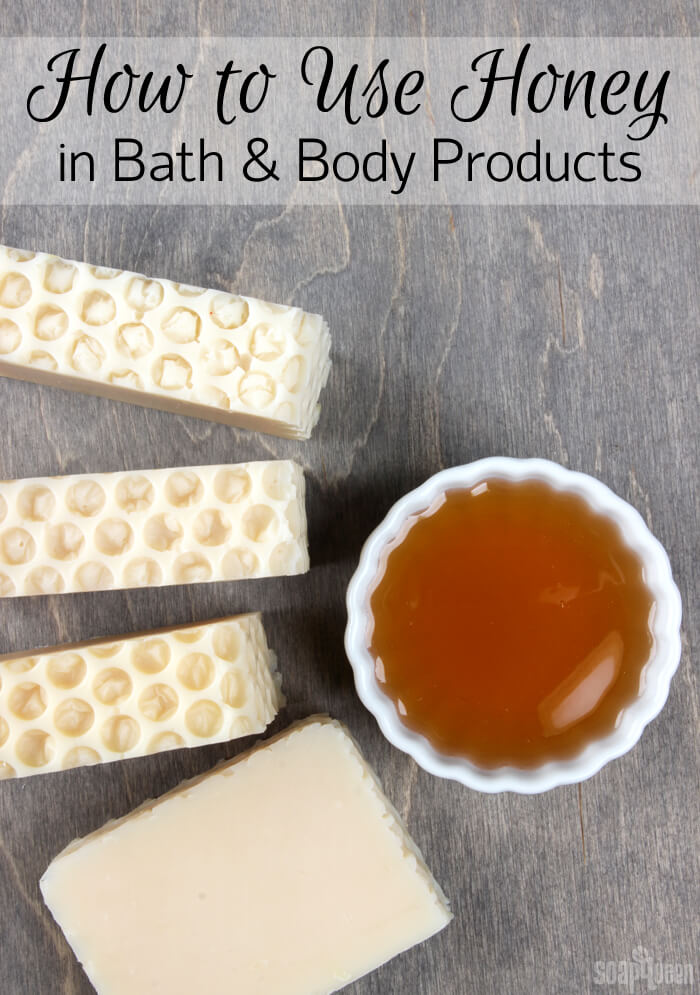
A humectant is an ingredient that absorbs moisture from the air. Natural humectants include aloe vera gel, eggs and honey. The humectant properties of honey, combined with its antioxidant properties, make it a popular choice for homemade bath and body projects. But, due to the natural sugars, water solubility and texture, it can be tricky to use properly. If you’d like to incorporate honey into your next project, the tips below will help.
Using Honey in Cold Process Soap
Honey in cold process soap gives additional humectant properties, helps create bubbles and is great from a marketing standpoint. It can be added to the soap at trace, or to the soaping oils prior to adding lye. Some soapmakers dilute the honey in a portion of the water in their recipe, and add the mixture at trace. How you add honey to cold process soap is a personal preference.
Keep in mind when you add honey to cold process recipes, you’re adding sugar. Cold process soap can become quite hot once the saponification process begins. Extra sugar in the soap batter will increase the temperature even more, which can cause the sugars to scorch. The scorched sugars produce a kind of caramelization in the soap, as well as a darker color. The extra heat also increases the likelihood of cracking, acceleration or a “soap volcano.”
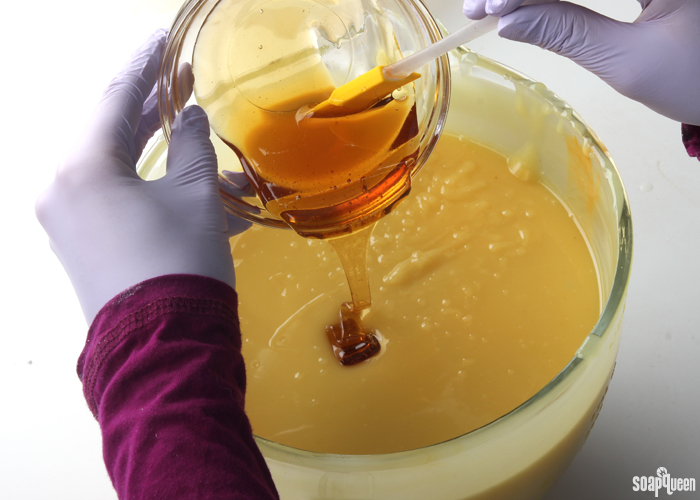
The key to adding honey to cold process soap is not using too much, and keeping temperatures cool. In general, I recommend about 1 teaspoon of honey per pound of total soap. You can add more. But, the more honey you add, the hotter your soap will become. I also recommend soaping on the cooler side, with lye and oils around 100° F. Then, place the soap in the fridge or freezer after pouring to keep it cool during the first few hours.
In the photo below, you can see what happens when honey becomes extremely hot in cold process soap. Both batches contained 2 teaspoons honey per pound of soap, which is more than recommended. Even when the soap was placed in the freezer, the soap got quite hot in the center! Click here to read more about using honey in cold process soap.
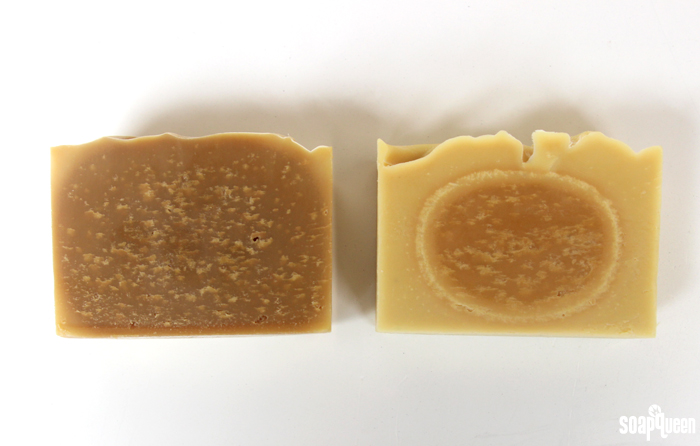 Using honey in cold process soap causes the soap to heat up and sometimes scorch, as shown above. Click here to learn more about using honey in cold process soap.
Using honey in cold process soap causes the soap to heat up and sometimes scorch, as shown above. Click here to learn more about using honey in cold process soap.
Using Honey in Melt & Pour Soap
It can be tempting to add oils and butters to melt and pour soap base. After all, it’s fun to make it your own formula! But, because melt and pour soap has already gone through the saponification process, additional oils and butters can cause the soap to not harden properly. Adding oils and butters can also increase sweating or inhibit lather. If you’d like to customize your base, I recommend no more than 1 teaspoon of extra oils or butters per pound of soap base.
I recommend 1/2 teaspoon per pound when adding honey to melt and pour soap base. Too much honey in melt and pour will cause the soap to become soft, increase glycerin dew, or the honey may separate from the base. The Honey Melt and Pour Soap Base is an easy way to incorporate honey into your melt and pour projects. Honey is the 5th ingredient in the base, which gives it a wonderful warm color.
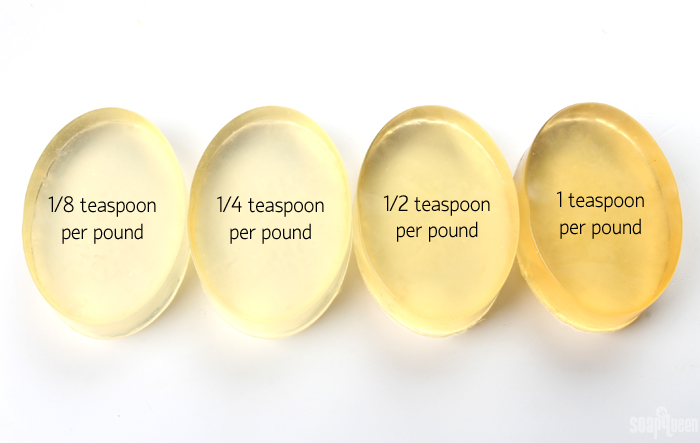 I tested adding honey to melt and pour at different usage rates. The soap with 1 teaspoon per pound of soap was quite dark, and slightly softer than the other bars.
I tested adding honey to melt and pour at different usage rates. The soap with 1 teaspoon per pound of soap was quite dark, and slightly softer than the other bars.
Out of curiosity, I tested adding honey into Clear Melt and Pour Base at different usage rates. I was curious to see how honey affects the color, lather and texture of the soap. In the photo above, the soaps (left to right) contain 1/8 teaspoon honey per pound of soap, 1/4 teaspoon per pound of soap, 1/2 teaspoon per pound of soap and 1 teaspoon per pound of soap. The more honey the darker the color of the soap. Once fully cooled, most of the bars were still firm. The only exception was the bar containing 1 teaspoon per pound – it was slightly softer. In the photo below, you can see the sides of the soap became slightly squished when firmly squeezed.
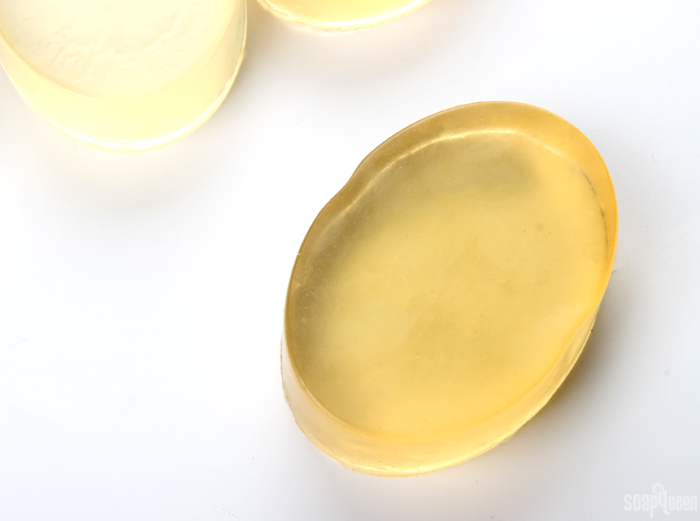 Adding extra honey to melt and pour soap base can cause the soap to become softer, as shown by the dent edges in the soap above.
Adding extra honey to melt and pour soap base can cause the soap to become softer, as shown by the dent edges in the soap above.
I tested the lather of the soaps containing 1/8 teaspoon honey per pound and the 1 teaspoon honey per pound. The soap with a full teaspoon of honey per pound of soap had a very dense, creamy lather. The soap containing 1/8 teaspoon honey per pound had a slightly fluffier lather. Both were lovely! The extra honey weighed down the bubbles, causing the creamier lather.
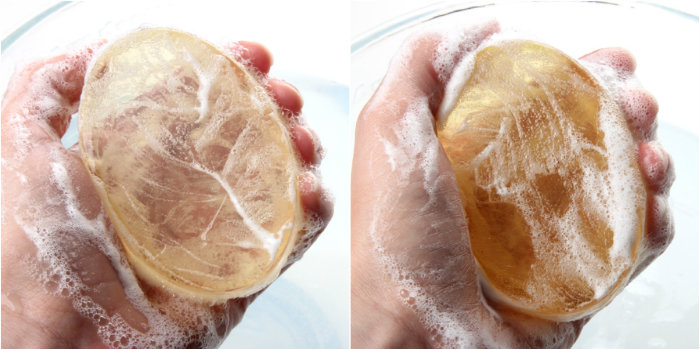 On the left, the soap with 1/8 teaspoon honey per pound of soap had a fluffy lather. The soap on the right with 1 teaspoon honey per pound had dense, creamy lather.
On the left, the soap with 1/8 teaspoon honey per pound of soap had a fluffy lather. The soap on the right with 1 teaspoon honey per pound had dense, creamy lather.
Using Honey in Lip & Body Balms
Honey is water soluble, which means it dissolves in water. Honey will not incorporate fully into recipes that are 100% oils and butters, like lip and body balms. Below, I added 1/2 teaspoon of honey to 4 ounces of the Nourish Lip Balm Base. Notice the little drops at the bottom? That’s the honey…not mixing in.
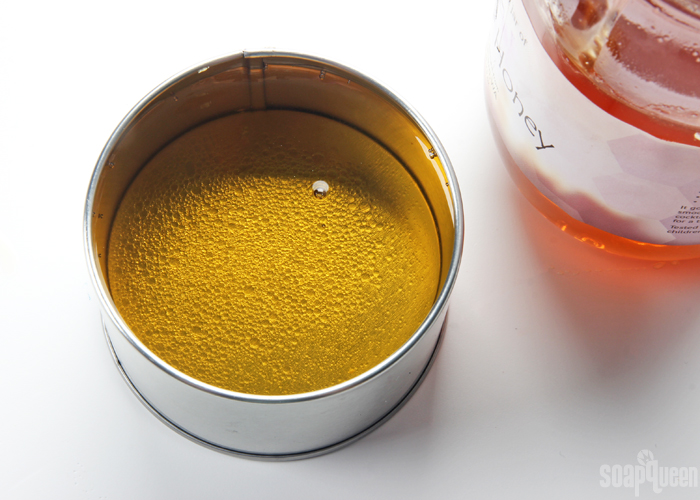 Honey does not mix into anhydrous products without an emulsifier. Above, you can see drops of honey at the bottom of the container.
Honey does not mix into anhydrous products without an emulsifier. Above, you can see drops of honey at the bottom of the container.
Even after plenty of mixing, honey does not mix into combinations of oils, waxes and butters. If you used honey in your balm, it may look great at first. But after a few weeks, the honey can start to separate from the balm. The balm can also take on a grainy appearance. Susan of Point of Interest (aka Swift Crafty Monkey) has a great article about using honey in products. This post also dives into the “science-y” aspects of why honey does not mix into oil-based products. The photo below is the same balm shown above. From the top, the balm looked perfectly fine! But, once I sliced into the balm and revealed the bottom, you can see all the honey sitting at the bottom of the container.
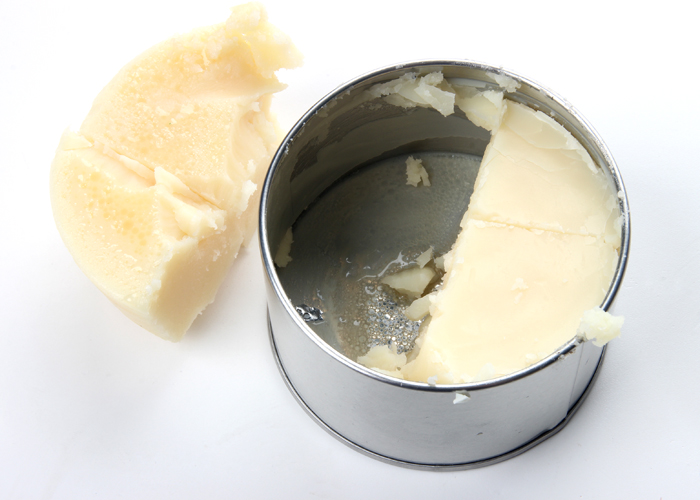 While the top of this balm looked great, the honey sank to the bottom of the balm.
While the top of this balm looked great, the honey sank to the bottom of the balm.
If you’d like to use honey in a balm or other anhydrous product, you need to use an emulsifier. The addition of honey to oil-based products also requires a preservative. Any product that contains water requires a preservative. Interestingly, honey contains a small amount of water. Use an oil soluble preservative like Optiphen or Phenonip when adding honey to anhydrous products. To learn more about preservatives, check out this post.
Using Honey in Emulsified Products (ie: lotion, emulsified scrubs)
Because honey is a water soluble product, it incorporates best in recipes that contain water, like lotion. Honey should be added to the water phase of any emulsified recipe and fully dissolved. A little honey in your emulsified products goes a long way, I would recommend 5% or less of your total recipe.
While honey does boast some antibacterial activity, it is not an effective preservative in products. If you are using honey in your lotion or emulsified product, it’s crucial to use a preservative to prevent mold and bacteria growth. We recommend a strong preservative when creating emulsified products containing honey, such as Germaben. If you’d like to learn more about preservatives, Susan from Point of Interest wrote an awesome guest post on the subject.
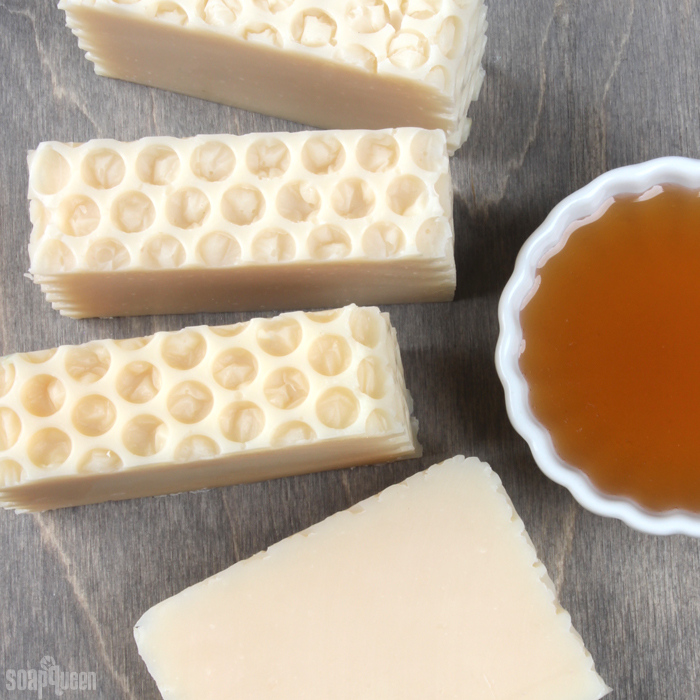
How do you like to use honey in your products? Do you have any observations to share? I’d love to hear them!